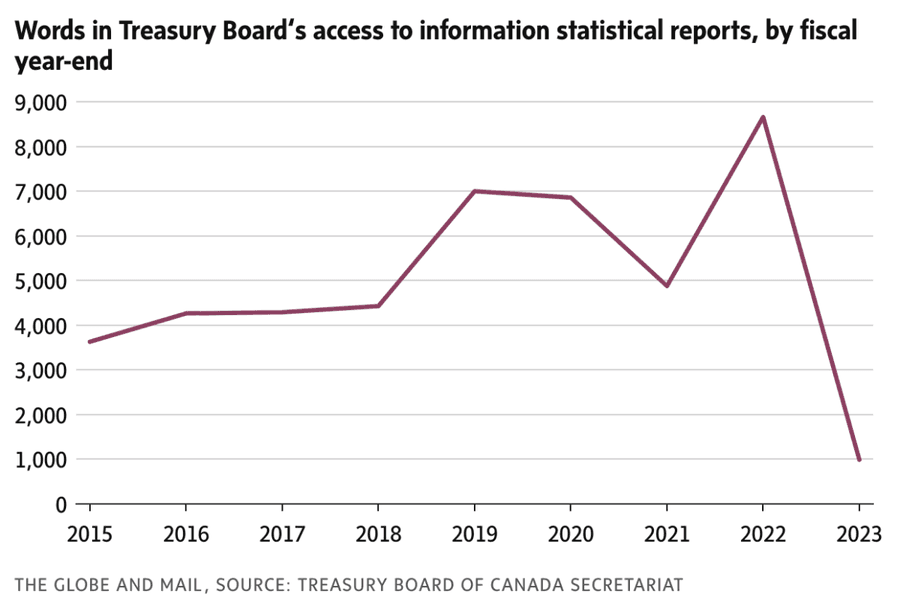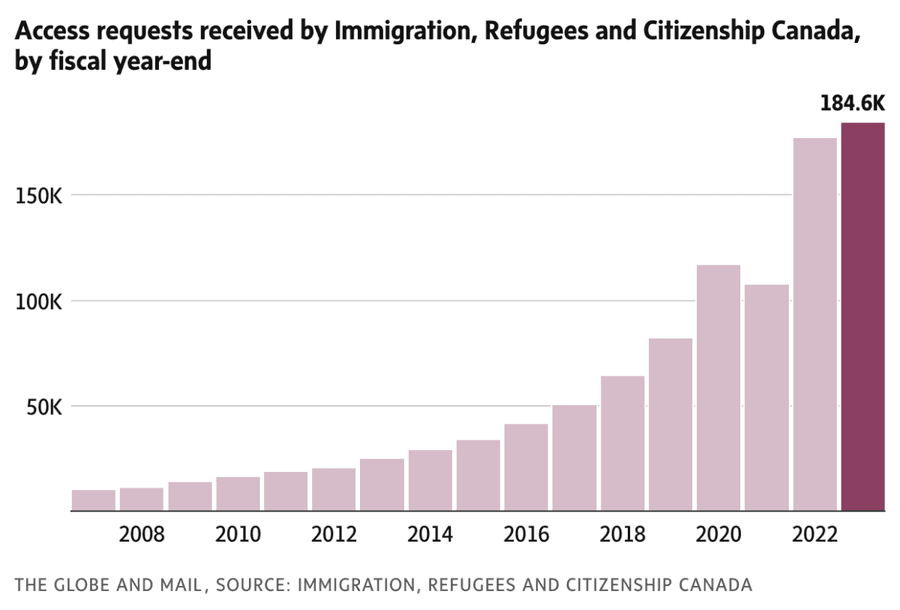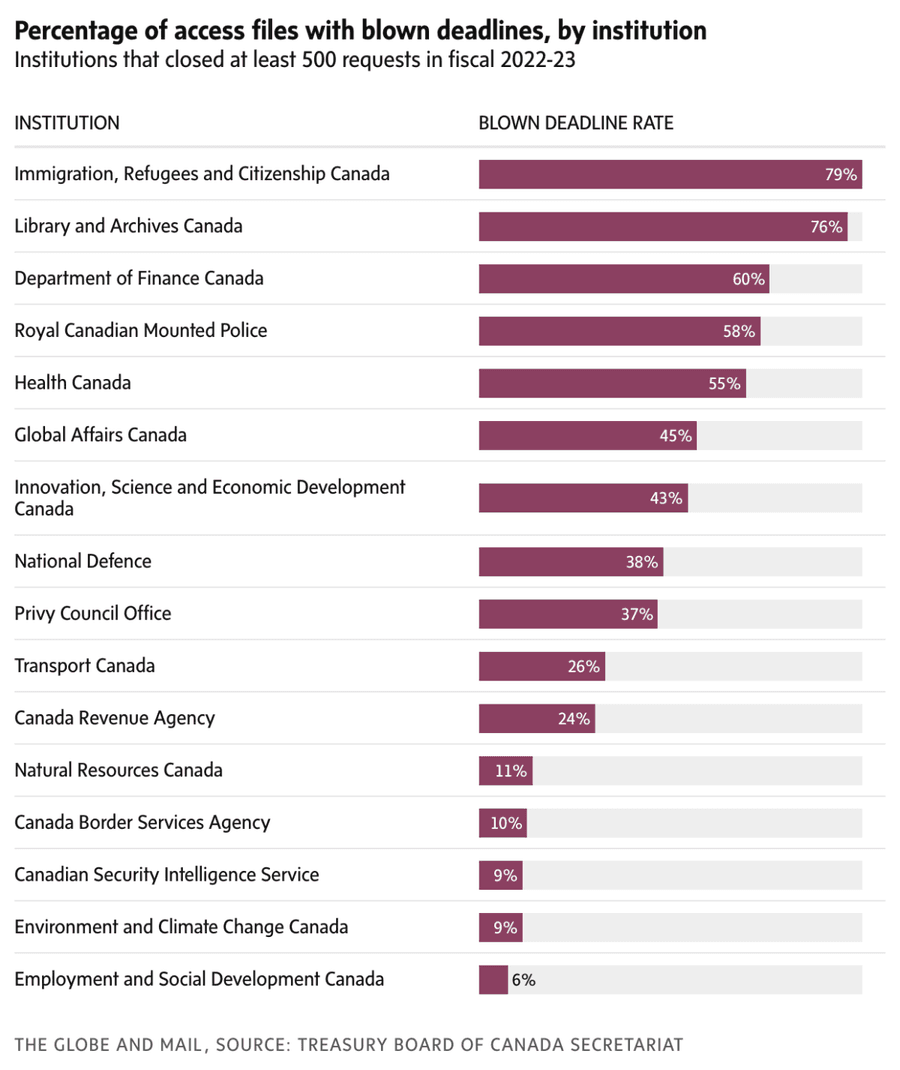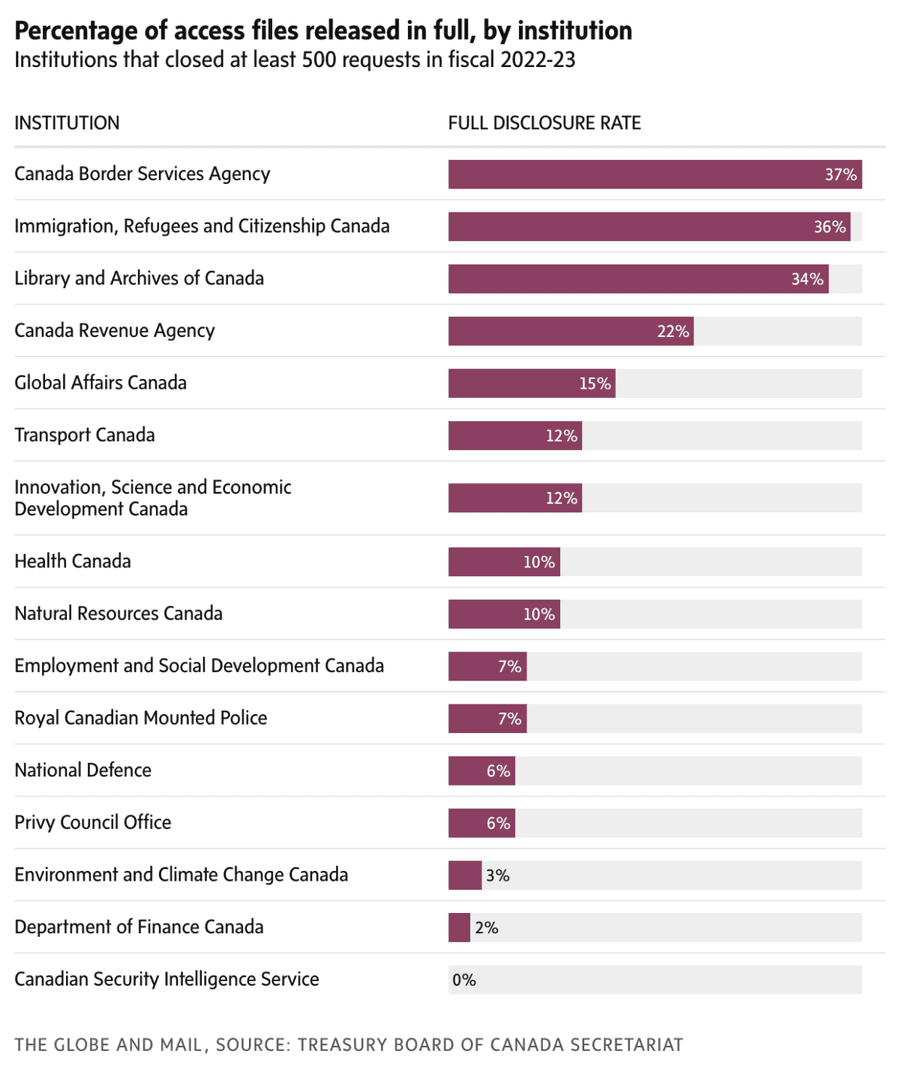Four charts that break down the latest federal access to information statistics
Published on February 7, 2024

Those of us who keep tabs on Parliament Hill’s delicate ecosystem – journalists, lobbyists, public servants and politicians – make a point of monitoring the House of Commons’ “journals,” a daily record of the business presented to the chamber, including committee reports, motions and document tablings.
Each fall, a slew of similar reports start popping into the journals. These documents reflect each federal public institution’s performance on the Access to Information Act and Privacy Act; that data eventually gets compiled by the Treasury Board of Canada Secretariat into a larger report on the state of Ottawa’s access system.
These reports are required by law and painstakingly produced, often by hand; last year, several public servants told me they had no automated way to generate these stats. They’re also published months after the fiscal year-end (which goes from April 1 to March 31 the next year), in the fall or early winter, long after they would be most useful to journalists keen on writing about how the federal access to information regime is faring.
The Treasury Board’s most recent report, published on Dec. 19, 2023, came too late in the year for a story in The Globe and Mail – but I dug through it this past week for the Secret Canada blog. Here are four charts and takeaways from the federal government’s latest data, which looks at the fiscal year from April 1, 2022, to March 31, 2023.
Whither the analysis?
Historically, the Treasury Board’s access reports have provided detailed analysis and descriptions of the trends in access and privacy. Not so this time around. Instead, the government has opted to provide some brief paragraphs accompanied by a list of tables and charts. While those may be useful for people seeking the briefest of overviews, I can’t help but wonder whether journalists, academics, researchers and public servants will end up less informed about the state of the federal system.
I was curious to quantify this discrepancy, so I wrote a simple one-line piece of code to count the number of words in each recent report and charted the results:

That’s a significant drop. Prior to 2022-23, the government was averaging 5,500 words per report. This amounts to an 82-per-cent drop compared with the average, or an 89-per-cent drop compared with the previous year.
Immigration still rules the roost
Immigration, Refugees and Citizenship Canada notched another record year for access requests. IRCC, which for years has received by far the most access requests of any federal public institution, logged 184,587 new files in 2022-23, compared with 52,377 for the rest of the government combined. That means access to information requests to the department account for 78 per cent of the federal total.

Staff in IRCC’s access office may be breathing a small sigh of relief, however: The department saw a 4-per-cent year-over-year increase in access requests – far less than the 65-per-cent uptick they’d logged the previous year.
Delays still rampant
Delays are still common in the federal system. According to the data, roughly 28 per cent of access requests (excluding those to IRCC) were completed outside legislated timelines, meaning the government broke the law on request timelines in close to a third of cases. The report also notes that just 54 per cent of institutions met the Treasury Board’s performance target on timeliness, which aims for 90 per cent of all access requests to be closed within legislated deadlines.
If we factor in IRCC, the overall delay figure becomes far worse. IRCC’s statutory timeline violation rate sat at 79 per cent in 2022-23; given the enormous volume of requests the department handles, the government as a whole blew its legislated deadline 67 per cent the time. That’s two-thirds of all requests!
When it comes to blown deadlines, IRCC ranked first among major access request-processing institutions (i.e. those closing 500 or more files last fiscal year), but was followed close behind by Library and Archives Canada (76 per cent). The Department of Finance (60 per cent), RCMP (58 per cent) and Health Canada (55 per cent) rounded out the top five.

If we expand our criteria to look at all federal institutions, a handful of bodies managed worse rates than IRCC. The Canadian Museum of Nature (two access requests) and the Office of the Administrator of the Ship-source Oil Pollution Fund (one access request) both had 100-per-cent lateness rates. They were followed by the Communication Security Establishment (54 requests, 81 per cent of which were late) and the National Arts Centre (5 requests, 80 per cent).
Redactions still the norm
Most completed access files still see some form of redaction. Federal institutions disclosed access files in full (that is, without redactions) just 32 per cent of the time, or 21 per cent, if you exclude IRCC.

Among major institutions, the Canada Border Services Agency managed the best full disclosure rate, at 37 per cent. IRCC came close behind (36 per cent), followed by Library and Archives Canada (34 per cent), the Canada Revenue Agency (22 per cent) and Global Affairs Canada (15 per cent). On the other end, the Canadian Security Intelligence Service, which closed 1,320 requests in 2022-23, released just four in full, for a disclosure rate of 0.3 per cent.
Other stuff, in brief
Storied FOI journalist Dean Beeby dug into these stats in December for a look at how frequently journalists are using the federal access system. He found that it’s “clear the media are abandoning the Act in droves.” You can read his post here.
Matt Malone at Thompson Rivers University pointed out that legal advice was sought in 495 access requests last year. Innovation, Science and Economic Development Canada topped the list, seeking out lawyers in 177 requests. The Canadian Broadcast Corporation came in second, with 39 requests.
This may be my favourite thing in the stats this year: 212 access requests were filed via fax. Yes, you read that right. Only seven institutions received faxed requests: the Canada Revenue Agency (122), Correctional Service Canada (23), Library and Archives Canada (22), the Canada Border Services Agency (20), Employment and Social Development Canada (17), Innovation, Science and Economic Development Canada (4), and the RCMP (4). Congratulations to them for having staff that know how to use a fax machine!
We'd love to hear about how you're using Secret Canada. Send us a note or use the hashtag #SecretCanada on social media. This information helps us grow the project.
To stay updated on FOI news, upcoming data releases and new features, sign up for The Globe's Secret Canada newsletter.

